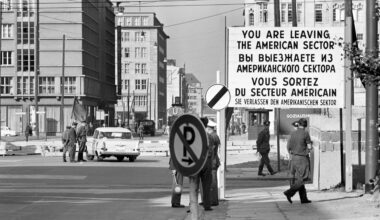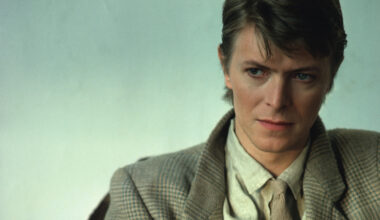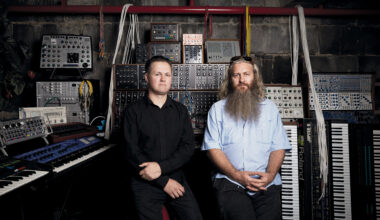Jez Kerr, Martin Moscrop and Donald Johnson discuss the happy accidents brought them together, the origins of ACR’s distinctive funk-fuelled sound and reveal Tony Wilson’s management wiles…
“Factory was an art thing,” says A Certain Ratio’s Jez Kerr, pondering the magnetism of the famous Manchester record label. “It wasn’t just about the records, it was about the style.”
One of the first bands signed to Factory, A Certain Ratio helped to define the label’s distinctive look and sound, from their Peter Saville-designed record sleeves to their individualistic output.
A product of Manchester’s burgeoning late 70s music scene, which generated such originals as Magazine, Joy Division and The Fall, A Certain Ratio were different even within that sphere, spurning guitar scree and abrasion in favour of a more original mix. Drawing heavily from funk, dub and experimental electronics, the band – singer Simon Topping, guitarist/trumpeter Martin Moscrop, drummer Donald Johnson, bassist/vocalist Jez Kerr and guitarist Pete Terrell – combined the music they’d heard going out to clubs and gigs in the city into a distinctive ACR compound.
“When I was 14, I used to go to the local discos around Manchester,” says Kerr, “and all the music they were playing was northern soul, James Brown and disco. That was what we were listening to, and then punk happened, and there were all these other weird bands. Wire and people like that, Throbbing Gristle, Velvet Underground were a bit of an influence too. We listened to a lot of dance music, because that’s what we grew up with. When you go out, you go to dance. Then when the punk thing happened, it opened up a whole new vista.”
A crucial conduit for Manchester’s bubbling creativity of the time was Pips Disco, a nightclub in a Fennel Street basement with themed rooms that played primarily 70s musical heroes of the more experimental stripe. There was a Bowie and Roxy Music room, and later a Kraftwerk room, and bands would also perform live there. Pips was the nucleus around which the earliest incarnation of A Certain Ratio formed, when Jez Kerr happened to see an embryonic version of the band gigging at the venue.
“Pete was playing guitar and Simon was playing bass,” says Kerr. “They had a noise generator and Simon was doing the vocal; they played in the Roxy room. I thought they were interesting, but I wasn’t really a musician. I’d been a footballer, but had broken my ankle badly, so that put paid to that. I had a bass, but I had no pretensions, I sort of knew people at Rabid Records so I was talking to Pete about it after their gig, saying, ‘I know a few people’. Then about two months later, I bumped into Simon on the street, and he said, ‘We’ve got a gig at Band On The Wall, we’re looking for bass players’. I said, ‘Well, I’ve got a bass’. We played at my place and we had about four songs, including ‘All Night Party’, then I did a gig with them on the Thursday.”
Martin Moscrop joined the band after another gig at Band On The Wall, an equally important venue in Manchester’s post-punk history.
“I was playing in a Stockport punk band called Alien Tint,” says Moscrop. “We both played on the same bill at one of the regular Manchester Musicians Collective nights. I saw A Certain Ratio and thought, ‘Wow, what’s this?’. There were just three of them and I thought it was amazing. Then they saw Alien Tint and thought, ‘What’s he doing in that band, he looks really out of place’. I was dressed the same way as them, with demob trousers and a white shirt. I got talking to them after the gig and said, ‘I really like your stuff’. They said, ‘We really like the way you dress, do you want to join us?’. It became a four-piece pretty quickly.”
Word about ACR spread fast, and after witnessing them play, Rob Gretton told Tony Wilson about the band.
“Tony really liked us,” says Moscrop. “He thought we were Manchester’s answer to The Velvet Underground. Pretty soon after that we were making our first record.”
That first record was ‘All Night Party’ [FAC 5], backed with ‘The Thin Boys’. A dirge of post-punk gloom, the record bore little resemblance to the sound A Certain Ratio would rapidly cultivate.
“When we recorded ‘All Night Party’,” says Moscrop, “we were still listening to Wire, Brian Eno, that sort of thing.”
Without a drummer, ACR lacked the percussive bustle that would become their trademark. When skilled player Donald Johnson was brought in by Tony Wilson to audition for the role, they instantly gelled, and the band’s sound truly crystallised.
“Donald came to rehearsal and we played our set, which we’d been playing for a few months,” says Kerr. “We just said, ‘Play along’. We were like, ‘Fucking hell, this is great, that’s it’. You know? We started rehearsing, and for us, Donald was technically brilliant as a drummer, he was the most advanced of us, and it sort of developed from there.”

Johnson’s influences were broad, spanning jazz and funk to rock and classical, and he instantly imparted a rhythmic sophistication that up to that point had been lacking.
“I was listening to everything, devouring it all,” says Johnson. “Earth, Wind & Fire, Sly Stone, James Brown, Cameo, Stanley Clarke, Chick Corea, Return To Forever, George Duke, all that kind of thing. But at the same time I was listening to David Bowie, T.Rex, an eclectic mix. And what people might not realise, a lot of classical music too, Elgar and things like that.”
Combining their numerous more soulful inspirations and channelling them through a grimy, jagged post-punk lens, A Certain Ratio’s genius mixture was first evident on the 1980 single ‘Shack Up’, issued through Factory Benelux, a cover of Banbarra’s heavy funk track. With dual trumpets, scratchy guitar, plus the tight rhythm section, it imagined a new Mancunian punk funk that became hugely influential to generations of bands since, from The Happy Mondays and The Stone Roses up to artists such as LoneLady today.
“Banbarra’s ‘Shack Up’ was a seven-inch single that Simon borrowed off his girlfriend, and played to us,” says Moscrop. “We thought, ‘Fucking hell, we can do that’, because the trumpet was just two notes, the guitar riff was just diddly-deh-diddly-deh, the bassline was dead simple. We had Donald as a drummer, so it was such an easy tune to do. We thought, ‘Let’s try to play it’, not with the intention of making a record or anything, but just having a bash, and it turned out really good. We ended up recording it.”
Tony Wilson was a great believer in A Certain Ratio. Once proclaiming them to be the next Sex Pistols, he not only signed the band to Factory, but managed them too. The band’s memories of Wilson’s vision range from the humorous to the heartfelt, but all are fond.
“I remember rehearsing for a show in Belgium,” says Johnson, “and you go to your manager and ask him for things, you know, ‘Tony, this is broken, we could do with this, with that’. His words were, ‘Don’t bother me now darling, I’m reading Proust’.”
“To us, he was a TV presenter,” Kerr adds. “He was presenting all the bands we liked on his show, ‘So It Goes’. He was in love with A Certain Ratio, he really rated us, whereas a lot of people said, ‘Oh they’re shit’. To have someone like that who was quite influential as a mouthpiece for punk, to have his backing and to be invited into the Factory family, with Joy Division, Section 25, Durutti Column, Orchestral Manoeuvres In The Dark, that was amazing.”
“Tony was a really creative guy,” says Moscrop. “He was so full of ideas. When I think about it now, I try and imagine where he got his energy from. He had a full time job at Granada as a news presenter and journalist, then he had ‘So It Goes’, so he was working on two TV programmes, and he was putting on nights at the Factory and starting his own record label, managing ACR. He was non-stop doing stuff. This was before the days of mobile phones or email or internet. I’ve just got no idea how he did it.”
There’s plenty of anecdotal evidence for Wilson’s colourful personality. One incident from when the band were on tour in New York City sticks in Jez Kerr’s memory.
“Tony used to have this saddlebag, you know like a man bag,” he says. “He thought he was trendy, he was dead proud of it. We’d only just arrived, and he’d gone out somewhere, come back, and had just been mugged. He had $10,000 of traveller’s cheques on him, which was the whole money for the tour. Some guy comes out and sticks a gun in his face. Tony, much to his credit, had been told by Chuck, the guy who rented us the place we stayed in New York – he was in ‘Goodfellas’, the guy who got garrotted, Morrie with the hairpiece – a word of advice when he arrived: ‘Keep $10 in your top pocket, and if someone mugs you, get the money out, hand it over and keep walking’. Tony gets the $10 out, gives it him and starts walking past. That was it. The tour could have been over quite quickly.”
Wilson’s belief in the band saw them releasing their debut collection ‘The Graveyard And The Ballroom’ [FACT 16] through the label. It was a compilation of demos recorded at Graveyard Studios in Prestwich on side one, and on side two, a live set recorded at London’s Electric Ballroom. Released on cassette only, in limited edition colour wallets, it was an early indication of Factory’s desire to stand out with their superior design, though, according to Donald Johnson, it was on tape for another reason.
“The wallets of ‘The Graveyard And The Ballroom’ were all Tony’s idea,” says Johnson. “That thing of different colours, having it like that. One of the other things I loved was the fact he wanted it to be cassette only, because Malcolm McLaren had done something similar with Bow Wow Wow, and he didn’t want McLaren to have that accolade just to himself.”
Despite the prosaic reasoning of the title relating to where each side was recorded, ‘The Graveyard And The Ballroom’ is truly the kind of set you could imagine skeletons shimmying to, mixing a strong funk undercurrent with, in places, an overcast bleakness and gothic edge. With a sound like Larry Graham slapping his bass from the bottom of a dank well, lyrics to tracks such as ‘Crippled Child’ added a disturbing edge to the funky gloom. For A Certain Ratio, the combination was inevitable. At that point, they were unable to play straight-up funk, so instead, they blended it with the pervasive mood of the time in Manchester.
“We couldn’t pretend to play disco music or dance music, we just played what we could, which was very minimal,” says Kerr. “We did sound different from everybody else, and I think the good bands were like that – Manicured Noise, The Fall, Joy Division. They didn’t sound like anyone else, they were on their own little planet and developing a sound, feeling the way. Not many of the people involved were technically great musicians, it was more about the idea.”
“With the aftermath of punk,” Moscrop adds, “our early music still had that vibe in it because we couldn’t play our instruments, so we naturally played that punky style of music, but with a weird edge.”

By the band’s account, Manchester at the time was a dreary place though, reckons Moscrop, its darkness only helped stoke the artistic fires of local bands. With a host of places for them to play, the scene could develop.
“It was very gloomy, there was not a lot to do, so people veered towards being creative,” he says. “I’ve got a theory that in the winter, when it’s raining and it’s really horrible, people tend to stay indoors, and they tend to be more productive. Creative people quite often come from those types of climates. It’s nice when the sun’s shining, but you tend to make happier music, don’t you? If it wasn’t for the Musicians Collective, I don’t think we would have got to what we were doing, because it allowed people to do gigs every two or three weeks, which we did.
“A lot of people used to go to the Musicians Collective nights to see bands. I think that helped spark it off, and then after that was The Factory, the Russell Club, which Tony and Factory co-founder Alan Erasmus started. Tony used to have bands like Suicide on, or Public Image, or Pere Ubu. You got to see all these bands you wouldn’t normally get to see, because they were on his TV programme on a Thursday, then they’d do the gig on a Friday. It was the people who put on those nights who really helped to push the music forward. There was another venue called the Beach Club that was run by Richard Boon and Eric Random, that’s where New Order played their very first gig supporting ACR. All these little clubs really helped Manchester music.”
Another reason that A Certain Ratio’s early material had a crepuscular tinge was Martin Hannett’s involvement. As in-house producer for Factory, he shrouded everything from The Durutti Column to Joy Division and ACR in his signature iciness, which helped to define the label in its early days. His aura pervades the band’s first album proper ‘To Each…’ [FACT 35] and especially tracks such as the permafrost textures of ‘Felch’ and the hypnotic weirdness of ‘Winter Hill’.
“The one bit of glue that held everything together in the early days was when Martin Hannett produced everything, he gave Factory its sound,” says Moscrop. “When you saw Vini Reilly or ACR live, they wouldn’t sound like they would when Martin Hannett produced them. All of it had quite a similar feel, but that didn’t last for long because as bands got a foothold, we didn’t want to sound like that.”
Indeed, sometimes Hannett would clash with band members when he was unprepared to compromise his particular aesthetic.
“He had an idea about drums and percussion and making things sound a certain way, which wasn’t always ideal to me,” says Johnson.
For their second album, ‘Sextet’ [FACT 55], A Certain Ratio switched up their sound and, without Hannett’s dominance over the mix, they progressed further towards the funk that inspired them. Still, with darker-edged tracks such as ‘Lucinda’, the psychedelic dub disco of ‘Knife Slits Water’ and the new presence of Martha Tilson on vocals, it was anything but conventional in style.
Relationship with Hannett notwithstanding, ACR believe that part of Factory’s success and appeal was in its family feel. Bands would look out for each other, share gigs and lend each other gear.
“It was like being in a movement, a movement based on making creativity happen in whatever form,” says Johnson. “As a family, it was that thing of everybody in it supporting everybody else in a non-jealous situation. Bernard and I were producing Section 25, and we were doing it to help them and to help us, because we were learning.
“New Order helped out massively, as they were the wealthiest. They were the ones who loaned out their very expensive equipment as and when they could. Our track ‘Brazilia’ was programmed on New Order’s DMX machine. Stephen Morris taught me how to use that. I learned how Prophet synths worked, what their rack of Voyetras did, what they were doing and how they did it. ACR did the same thing with Kalima and other bands, because they were making their way in the game as well.”
In this brave new era of independent record imprints, the bands signed to Factory were invested in the project of making the label work, not just furthering their own careers.
“Factory gave us the outlet for making a record and putting it out,” says Kerr, “however haphazardly they did that. It was like a home. Physically making the first EP, ‘A Factory Sample’ [FAC 2], I made about 1,000 of those myself. It took 10 minutes each, and I put them together and sealed them. It was a cottage industry, and it made you love it more. It was really exciting at the time.”
Factory’s strong visual aesthetic was another crucial piece of the jigsaw.
“Not many people know who we are, but they know the sleeves,” Kerr adds. “I think that was a really big part of what Factory were about. The artwork was really important to them, because that’s what people were seeing. There was no Debbie Harry, no star people. The imagery was what people would associate with. There’s the mystery, because fans read into those covers what they want. It was really important to get the right sleeve for your album or your single. Fortunately we worked with people like Ben Kelly and Peter Saville. Trevor Johnson, who’s been with us a long time, his stuff is just amazing. It had a continuity to it that I love.”
A Certain Ratio’s relationship with Factory continued until 1986, and many of their classic tracks from this period, as well as later gems from their electronic dance phase and plenty of unreleased songs are collected on the new ‘ACR:BOX’ set for Mute Records. Though the band have metamorphosed many times, and their output is eclectic to say the least, it’s astonishing how much variety there is in the Factory era songs.
“The early stuff, looking at it again,” says Kerr, “it’s so good because we didn’t really know what we were doing, and that’s a great thing. That’s what we’re always aiming for, which is doing it in the moment, playing live. I wouldn’t change a thing as far as the music goes, we did ourselves proud – and we’re still making it.”
‘ACR:BOX’ is out on Mute






